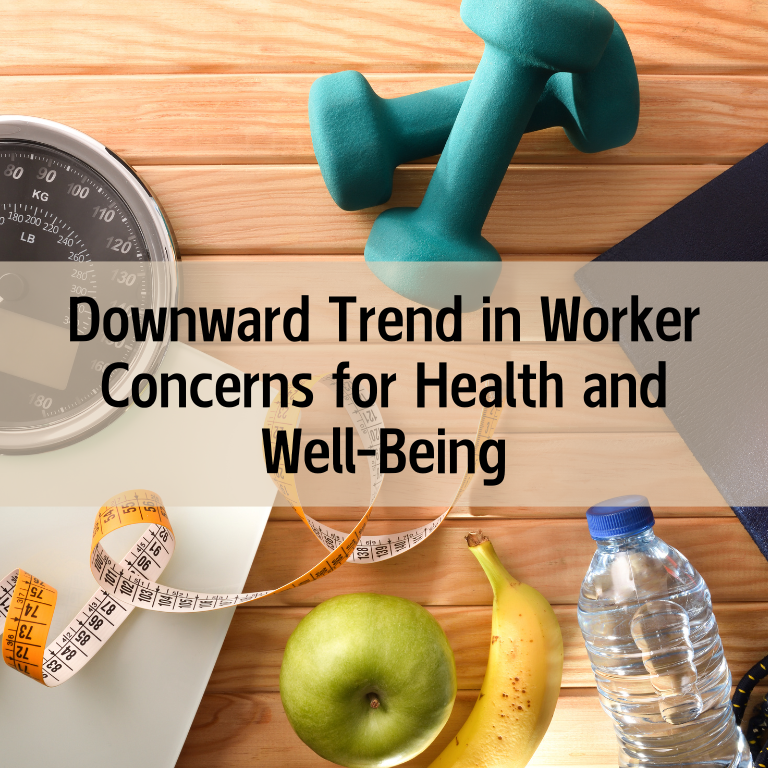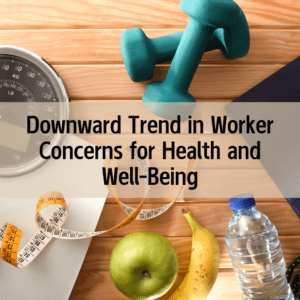Downward Trend in Worker Concerns for Health and Well-Being

In recent years, the focus on health and well-being in the workplace has steadily increased, driven by a growing awareness of the importance of mental and physical health on productivity and job satisfaction. However, new data suggests a downward trend in worker concerns for health and well-being, with fewer employees actively expressing these issues or seeking support for them. This shift, which comes as a surprise to many industry experts, could reflect changing workplace dynamics, shifts in employee priorities, or increased adaptation to post-pandemic working conditions.
In this article, we examine the possible reasons behind this trend, its implications, and how organizations can continue to prioritize health and well-being to maintain a supportive work environment.
Understanding the Downward Trend
The recent decline in reported concerns about health and well-being among workers contrasts sharply with the previous few years, when mental health, work-life balance, and personal well-being were top priorities. Data from multiple surveys and studies reveal that fewer employees are expressing concerns or engaging with workplace health programs. This downward trend raises questions about whether employees are experiencing improved health and well-being, have adapted to the existing challenges, or are facing barriers to voicing these concerns.
Several factors could be influencing this shift, from reduced awareness campaigns to shifting workplace norms in hybrid or remote environments. Exploring these factors is key to understanding how organizations can maintain a focus on employee well-being.
Potential Factors Contributing to the Decline in Worker Concerns
The COVID-19 pandemic was a significant disruptor, affecting physical health, mental well-being, and job stability worldwide. In the wake of the pandemic, companies responded with health initiatives, mental health resources, and hybrid work options, creating a work culture that prioritized well-being. Over time, employees may have developed resilience and adapted to the new work environment, leading to a decrease in concerns about health and well-being.
Employees accustomed to hybrid or remote work have also experienced improved work-life balance, reducing stress and burnout associated with commuting and rigid schedules. This could be a sign that employees feel more empowered to manage their own health needs and are less dependent on organizational support.
Economic Pressures and Job Security Concerns
Economic uncertainty, inflation, and fears of recession have intensified over the past year, prompting employees to prioritize job stability over health concerns. In many cases, workers may feel that expressing concerns about health could be perceived as a vulnerability, particularly in competitive job markets. In addition, layoffs in various industries have made employees more cautious about highlighting health issues, focusing instead on job performance and productivity.
This pressure to maintain job security can lead to a “silence culture,” where employees hesitate to voice personal needs, potentially contributing to a decline in reported health and well-being concerns.
Stigma and Barriers to Expressing Health Concerns
Despite significant strides in mental health awareness, stigma surrounding health issues remains a barrier for some employees. Cultural factors, workplace dynamics, and a lack of openness around personal issues may contribute to employees feeling hesitant to discuss their health and well-being openly. In environments where mental health discussions are less accepted, workers might avoid voicing concerns, even if they experience stress or burnout.
Additionally, employees who work remotely may lack the same channels for informal conversations with managers or HR personnel, which can lead to underreporting of issues compared to when they were in physical office settings.
Reduced Company Initiatives on Well-Being
During the early days of the pandemic, many organizations introduced well-being programs, including virtual counseling, flexible schedules, and mental health days. As pandemic restrictions eased, some organizations scaled back these initiatives, viewing them as temporary measures. A reduction in health and wellness programs or the scaling back of remote work options may make it more difficult for employees to access support, discouraging them from voicing health concerns.
Furthermore, the focus on profitability and efficiency in a post-pandemic world has led some organizations to allocate fewer resources to well-being initiatives, inadvertently signaling to employees that health concerns are no longer a priority.
Shifts in Employee Priorities
Younger workers and employees from generations who entered the workforce post-pandemic may have different expectations of health and well-being resources. With increased familiarity and comfort with technology, this generation may see personal health and self-care as independent responsibilities rather than relying on employer-provided resources. Many younger employees also value flexibility and autonomy over specific wellness programs, feeling empowered to manage their well-being independently through personal routines outside work.
This shift could indicate that while employees value health and well-being, they may not express these concerns directly to employers, focusing instead on finding solutions that align with their personal lifestyle.
Implications of Reduced Health and Well-Being Concerns
The decrease in expressed health concerns may have positive or negative implications for both employees and organizations. On the one hand, it may indicate that employees feel more in control of their health, have developed effective coping mechanisms, or benefit from a supportive work environment. However, it may also suggest underlying issues, such as a reluctance to voice concerns, a lack of resources, or reduced trust in organizational support.
For organizations, interpreting these results requires careful consideration. Ignoring potential underlying issues could result in higher turnover, reduced engagement, and lower productivity. Maintaining open channels for feedback and ensuring a supportive culture are essential, even when employee concerns seem less prevalent.
Strategies for Organizations to Address the Trend
While a decline in reported health and well-being concerns may seem like a positive indicator, organizations should remain proactive in supporting their employees. Here are some strategies to ensure that employee well-being remains a priority:
Encourage Open Dialogue on Health and Well-Being
Creating a culture where employees feel comfortable discussing health and well-being without fear of repercussions is crucial. Regular check-ins, anonymous surveys, and open forums can help employees voice their concerns discreetly. Managers can foster open communication by demonstrating empathy and encouraging discussions around work-life balance.
Reevaluate and Update Well-Being Programs
Organizations should continuously assess their health and well-being programs to ensure they meet the current needs of their workforce. This includes addressing the specific needs of remote and hybrid employees, considering virtual counseling, online fitness programs, and flexible work arrangements. Regular feedback from employees can help shape these programs to be more relevant and accessible.
Promote Self-Care and Personal Health Management
Empowering employees to manage their own health and well-being can be beneficial, especially for those who prefer autonomy. Organizations can promote self-care by offering resources on stress management, time management, and wellness practices. For instance, educational workshops on nutrition, mindfulness, and exercise can encourage employees to prioritize their health outside of work.
Ensure Accessibility and Inclusivity in Well-Being Initiatives
Organizations should focus on inclusivity in their health programs, ensuring accessibility for all employees. This includes recognizing the diverse needs of a multigenerational workforce and offering options that appeal to various lifestyles. Additionally, companies can ensure that remote employees have access to the same resources as in-office workers, reinforcing the message that well-being is a priority across all work environments.
Regularly Monitor and Adjust Based on Feedback
Implementing a feedback loop allows organizations to track how well their initiatives are resonating with employees. Periodic surveys, feedback sessions, and data analytics can help assess the impact of health and well-being programs. Adjusting these programs based on actual feedback ensures that employee support remains relevant and effective over time.
The downward trend in expressed worker concerns about health and well-being may be the result of adaptation, shifting priorities, or potential barriers to expression. For organizations, this trend serves as a reminder to remain vigilant in supporting employee health, even if fewer concerns are voiced. By proactively addressing the changing dynamics of workplace health, employers can continue to foster a culture that values well-being, ultimately benefiting both employees and the organization’s long-term success.
The landscape of employee well-being is continually evolving, and as companies adapt, so must their approach to ensuring that health and support remain fundamental to the workplace experience.











